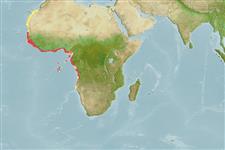Actinopterygii (ray-finned fishes) >
Gadiformes (Cods) >
Merlucciidae (Merluccid hakes) > Merlucciinae
Etymology: Merluccius: Latin, mar, maris = the sea + Latin, lucius = pike (Ref. 45335).
Environment / Climate / Range
Ecology
Marine; bathydemersal; non-migratory; depth range 50 - 1000 m (Ref. 112558), usually 50 - 550 m (Ref. 58452). Deep-water, preferred 25°C (Ref. 107945); 29°N - 19°S, 19°W - 15°E (Ref. 58452)
Eastern Atlantic: off the coast of tropical West Africa, from Mauritania to Angola. Range reported to extend to off southwest Africa near Cape Frio, Namibia (Ref. 6524).
Size / Weight / Age
Maturity: Lm ? range ? - ? cm
Max length : 80.0 cm TL male/unsexed; (Ref. 1371); common length : 40.0 cm TL male/unsexed; (Ref. 26999)
Short description
Morphology | Morphometrics
Dorsal
spines
(total): 1;
Dorsal
soft rays
(total): 45-52. Head large and little depressed. Pectoral fin tips usually reaching the origin of anal fin in small but not in large individuals. Scales easily shed. Color usually blackish on back, steel gray to blackish on belly; caudal fin white-edged.
Feeds mainly on small fishes and partly on squids and shrimps (Ref. 1371). Marketed mostly fresh and frozen, also used for fishmeal and oil (Ref. 1371). Minimum depth reported taken from Ref. 1371.
Life cycle and mating behavior
Maturity | Reproduction | Spawning | Eggs | Fecundity | Larvae
Cohen, D.M., T. Inada, T. Iwamoto and N. Scialabba, 1990. FAO species catalogue. Vol. 10. Gadiform fishes of the world (Order Gadiformes). An annotated and illustrated catalogue of cods, hakes, grenadiers and other gadiform fishes known to date. FAO Fish. Synop. 125(10). Rome: FAO. 442 p. (Ref. 1371)
IUCN Red List Status (Ref. 115185)
CITES (Ref. 94142)
Not Evaluated
Threat to humans
Harmless
Human uses
Fisheries: minor commercial
More information
Common namesSynonymsMetabolismPredatorsEcotoxicologyReproductionMaturitySpawningFecundityEggsEgg development
ReferencesAquacultureAquaculture profileStrainsGeneticsAllele frequenciesHeritabilityDiseasesProcessingMass conversion
Tools
Special reports
Download XML
Internet sources
Estimates of some properties based on models
Phylogenetic diversity index (Ref.
82805): PD
50 = 0.5000 [Uniqueness, from 0.5 = low to 2.0 = high].
Bayesian length-weight: a=0.00513 (0.00237 - 0.01110), b=3.08 (2.90 - 3.26), in cm Total Length, based on LWR estimates for this Genus-body shape (Ref.
93245).
Trophic Level (Ref.
69278): 4.5 ±0.63 se; Based on food items.
Resilience (Ref.
69278): Medium, minimum population doubling time 1.4 - 4.4 years (K=0.39(?); assuming tm>=2).
Vulnerability (Ref.
59153): Low to moderate vulnerability (35 of 100) .
